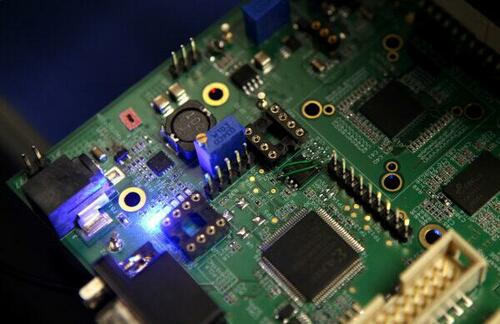As expected the battle for semiconductors is quickly heating up as one of the key front in the confrontation between China and the US. But unlike the Moon race of the 1960s between the USSR and the US, the weapons are not technology and science but sanctions, trade embargoes and restrictions dividing further the world into blocks.
The risk of such a strategy is that even if we escape a hot war in the short term, we will end up with a huge fracture zone with "sporadic eruptions" almost anywhere: Political plate tectonics on a grand scale! But unlike the cold war of the last century, this one will be fought with high-tech weapons and mercenaries guarantying a spillover in short order.
Silicon (article below), lithium, all rare elements, most metals (copper, titanium), food, energy... the list is endless and all without exception will sooner than later be under some kind of embargo. The post-war free trade world we have enjoyed over the last 70 years is truly over.
Authored by Jessica Mao via The Epoch Times (emphasis ours),

As every aspect of modern life becomes more and more digitized, not just the economies of nations but their sovereign influence will rely more and more on the command of technology.
Although the United States and China are not engaged in traditional warfare, they are engaged in a war of ideas, trade, and technology, especially in semiconductor hegemony, where both sides are battling for supply and advancement.
In recent years, the United States has made a series of moves to hinder and outpace Chinese development in semiconductors, including persuading Asian semiconductor powerhouses to join its alliance, passing a massive spending bill to aid domestic chip production, and banning exports of high-end chipmaking equipment to China.
In late July, the United States expanded its bans on exports to China of equipment that can make semiconductors up to 14 nanometers in size, according to major U.S. chipmaking equipment suppliers, such as Lam Research Corp. and KLA, who were notified by the government about the expanded restrictions.
Previously, the United States had banned the sale of equipment that can produce chips of 10 nm or smaller to Chinese chip manufacturers.
Generally in semiconductor fabrication, the smaller the process technology, the more advanced the chip. The smaller the technology node, the higher the transistor density and the lower the chip power consumption, resulting in higher performance. However, the smaller manufacturing process requires more advanced material and equipment, and will incur a greater cost in R&D and production.

The development follows a historic $52 billion bill passed by U.S. congress on July 27 to aid domestic chip makers in research, development, and production volume. One of the conditions is that the companies receiving the funds will not increase advanced chip production in mainland China.
The U.S. Department of Commerce said the tightening policies impair “PRC efforts to manufacture advanced semiconductors to address significant national security risks to the United States.”
Meanwhile, the United States is also reportedly planning to ban the exports of U.S. chipmaking equipment that produces advanced NAND chips to major Chinese chipmakers, such as Yangtze Memory Technologies Corp (YMTC).
YMTC is a state-owned company and China’s only storage NAND flash memory manufacturer competing with major U.S. manufacturers. Its global market share is about 5 percent. In a report released by the White House in June 2021, YMTC was identified as the “national champion” enterprise of the Chinese regime, having received $24 billion in subsidies from the Chinese government.
NAND chips are used to store data in a wide range of electronic devices such as smartphones and personal computers, as well as in the data centers of companies such as Amazon, Facebook, and Google.
If the NAND chip initiatives are officially issued, they will be the first time that the United States uses trade restrictions to contain China’s ability to produce non-military use memory chips, broadening the scope of protecting the U.S.’s national security and dealing a massive blow to Chins’s memory chip industry.
On Aug. 1, U.S. senators, including Senate majority leader Chuck Schumer (D-N.Y.), requested that the Department of Commerce add YMTC to the U.S. trade blacklist.
The move could further hamper the growth of China’s semiconductor industry and protect American companies; the only two U.S. memory chip makers, Western Digital and Micron Technology. The two account for about a quarter of the NAND chip market share.
According to a Bloomberg report, the United States is also pushing the Netherlands and Japan to stop the chipmaking equipment suppliers, ASML and Nikon, from selling lithography machines to China. The move could potentially deal a severe blow to major Chinese chipmakers such as Semiconductor Manufacturing International Corp. (SMIC) and Hua Hong Semiconductor Ltd.
US CHIPS Act
On July 26, the U.S. Senate voted to advance its Chips and Science Bill aimed at boosting domestic semiconductor production and improving technological competitiveness with China.
The bill was later passed in the U.S. House of Representatives on July 28 and signed into law by President Joe Biden on Aug. 2.

The legislation will provide $280 billion in funding to prop up and kickstart domestic semiconductor manufacturing and research; the price tag is far above previous legislation that aimed to provide just $52 billion to manufacturers.
Officially dubbed the CHIPS [Creating Helpful Incentives to Produce Semiconductors for America] Act of 2022, the measure would provide tens of billions of dollars in subsidies and tax breaks to technology corporations in an effort to spur new market growth, as well as funding for government-backed tech research.
Proponents of the legislation have long said that it’s necessary in order to maintain a competitive edge with China, which is pouring money into its own domestic chip production.
The legislation also clarifies that entities receiving U.S. government funding are prohibited from engaging in transactions involving substantial expansion of semiconductor manufacturing in China or any other foreign country of concern for at least ten years after the Act takes effect.
These restrictions are designed to prevent chipmakers from significantly expanding the production of chips more advanced than 28nm in China within the next decade.
Even though the 28-nanometer chips are a few generations behind today’s advanced semiconductors, they are still widely used in cars, lower-end smartphones, appliances, and more.
Chip 4 Alliance
The United States has also been working to persuade Asian semiconductor powerhouses to participate in its “Chip 4 alliance.”
The U.S.-led alliance aims to strengthen cooperation in the semiconductors industry among the United States and the East Asian powerhouses of Taiwan, South Korea, and Japan to build a secure supply chain that excludes China.
Taiwan and Japan have already agreed to participate in the Chip 4 alliance proposed by the United States this March, pending South Korea’s decision to join.
The United States has reportedly given South Korea a deadline to decide whether it will join the “Chip 4 alliance” by Aug. 31, according to local South Korean reports citing unnamed sources in Washington.

No comments:
Post a Comment